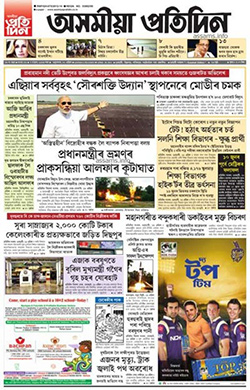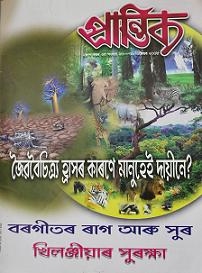
Buranjis are a class of historical chronicles and manuscripts associated with the Ahom kingdom written initially in Ahom Language and later in Assamese language as well. The Buranjis are an example of historical literature which is rare in India. They bear resemblance to Southeast Asian traditions of historical literature. The Buranjis are generally found in manuscript form, though a number of these manuscripts have been compiled and published, especially in the Assamese language.

Boro, also rendered Bodo, is a Sino-Tibetan language spoken primarily by the Boros of Northeast India and the neighboring nations of Nepal and Bangladesh. It is an official language of the Indian state of Assam, predominantly spoken in the Bodoland Territorial Region. It is also one of the twenty-two languages listed in the Eighth Schedule of the Constitution of India. Since 1975 the language has been written using the Devanagari script. It was formerly written using Latin and Eastern-Nagari scripts. Some scholars have suggested that the language used to have its own now lost script known as Deodhai.

Asomiya Pratidin is an Assamese daily newspaper catering to all of Assam, with five editions published from Guwahati, Bongaigaon, Dibrugarh, and North Lakhimpur. The other periodical and magazines published under Pratidin group are Sadin, Nandini and Satsori.

Assamese literature is the entire corpus of poetry, novels, short stories, plays, documents and other writings in the Assamese language. It also includes the literary works in the older forms of the language during its evolution to the contemporary form and its cultural heritage and tradition. The literary heritage of the Assamese language can be traced back to the c. 9–10th century in the Charyapada, where the earliest elements of the language can be discerned.
Bhabendra Nath Saikia was a novelist, short-story writer, editor and film director from Assam, India. Dr. Saikia received his doctorate in physics from the University of London. He began his career as a reader in the Department of Physics, University of Guwahati. He later played an important role in the publication of college level textbooks in the Assamese language during his tenure as the Secretary of the Co-ordination Committee for production of textbooks in regional languages.

Prantik is a multi-topic Assamese language magazine published fortnightly from Guwahati since 1981. It plays a vital role in the socio-political lives of the people of Assam, India.

Birendra Kumar Bhattacharya was an Indian writer. He was one of the pioneers of modern Assamese literature. He was the first ever Assamese writer to receive the Jnanpith Award, which was awarded to him in the year 1979 for his novel Mrityunjay (Immortal), followed by Indira Goswami in 2001. He was also a recipient of Sahitya Akademi Award in Assamese in 1961 for his Assamese novel Iyaruingam, which is considered a masterpiece of Indian literature. In 2005, a translation of the work published by Katha Books with the title Love in the Time of Insurgency was released. Another famous novel written by Bhattacharya is Aai (Mother).

Ambikagiri Raichoudhury (1885–1967) was an Assamese poet, lyricist, singer, powerful prose writer, news worker, magazine editor, patriotic, social-worker and the leading freedom fighter of India's freedom struggle. He is known as Assam Kesari. He was elected president of the Assam Sahitya Sabha in 1950.

O Mur Apunar Dekh is the state and traditional song of Assam, India. It was written by Lakshminath Bezbarua and the tune was made by Kamala Prasad Agarwala. It was first published in 1909 in an Assamese magazine named Bahi ("flute"). It was adopted as the Assam's state song in 1927 at asom chatrô sônmilôn held in Tezpur, and was officially adopted by the state government in 2013.

Christianity is the third largest religion in Assam, a state in the north-eastern region of India. The total population of Christians in the state is 1,165,867, which according to the 2011 census comprises about 3.74% of the state's total population. After Islam, Christianity is also the second-fastest growing religion of Assam. The largest concentration of Christians in Assam can be found in the Dima Hasao District, where Christians number approximately 30% of the population. The second largest concentration is in the Karbi Anglong district where they form approximately 16.5% of the population.

Orunodoi or Arunodoi was the first Assamese-language magazine published monthly from Sibsagar, Assam, in 1846. The magazine created a new era in the world of Assamese literature and gave birth to notable authors such as Anandaram Dhekial Phukan, Hemchandra Barua, Gunabhiram Barua, and Nidhi Levi Farwell. The magazine took the initiative of innovating the then Assamese dialect instead of borrowing words from other languages. The Assamese people got to know about the western world only through this magazine, which opened the gate to the modern literacy in Assam. It mainly included various news related to current affairs, Science, astrology, history and also trivia although Christianity was its main aim. The magazine's publishing ended when the printing press was sold in 1883.
Jonaki was an Assamese language magazine published from Calcutta in 1889. It was also the mouthpiece of the then Assamese literary society Oxomiya Bhaxa Unnati Xadhini Xobha in which the society’s aim and objectives were regularly expressed. The first editor of the magazine was Chandra Kumar Agarwala.
Assamese is part of the easternmost group of the Indo-Aryan languages. History of Assamese literature can largely be classified into three periods, including: Early Assamese period, Middle Assamese period and, Modern Assamese.

Jagannath Barooah University is a university located in Jorhat, Assam, India. It was founded on 19 August 1930. The College is recognized by University Grants Commission (UGC). It was accredited by National Assessment and Accreditation Council (NAAC), India in 2003.The College is promoted to University By Govt of Assam By The Jagannath Barooah University Act 2023 in 12 December of 2023

Lakshmi Nandan Bora was an Indian novelist and short story writer in the Assamese language, known for over 60 books he has authored, including award winning novels, Patal Bhairavi and Kayakalpa. A recipient of Sahitya Academy Award and Saraswati Samman, Bora was honoured by the Government of India in 2015 with Padma Shri, the fourth highest Indian civilian award. He died on 3 June 2021 from complications caused by COVID-19.
Roopkar was the first Assamese language, tabloid-sized magazine about Assamese cinema, theater and culture. Established in 1974, the magazine was founded and edited by journalist and writer Pabitra Kumar Deka. Advisers of the magazine were singer & composer Bhupen Hazarika and writer Nirode Choudhury.
Kumud Chandra Hazarika, popularly known as Ranju Hazarika is an Indian writer. In last four decades he has written over 750 books in Assamese language in different genres like Thriller, Social, Horror, Science Fiction, Children, Comedy, Adventure and considered as one of the most beloved writers of Assam.
The Sadou Asom Lekhika Samaroh Samiti is a non-government women’s literary organisation in Assam, India. It was founded in 1974 to unite and emancipate the women of Assam through creative pursuits, especially literature. It has more than two hundred branches all over Assam and in Kolkata, Shillong and Dimapur. The head office of the organisation is in Tezpur. The branches of the samiti also have offices in their respective places.
Surjya Kanta Hazarika is an Assamese litterateur, an eminent scholar, author, publisher, playwright, lyricist, composer, cultural activist, feature film and documentary maker, social worker and philanthropist. Hazarika is a recipient of the Padma Shri Award in 2008 for his contribution to Literature & Education. He is the current president of Asam Sahitya Sabha.













